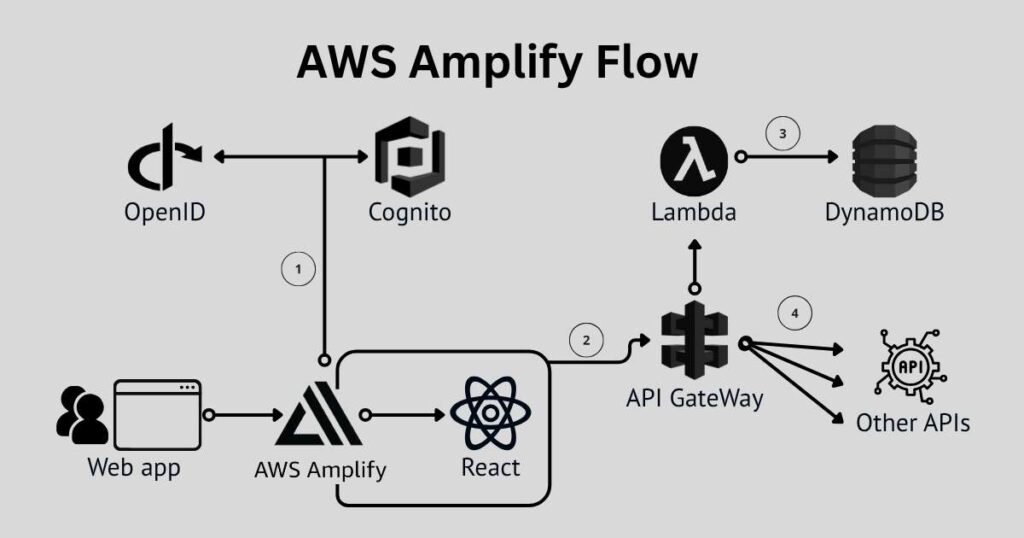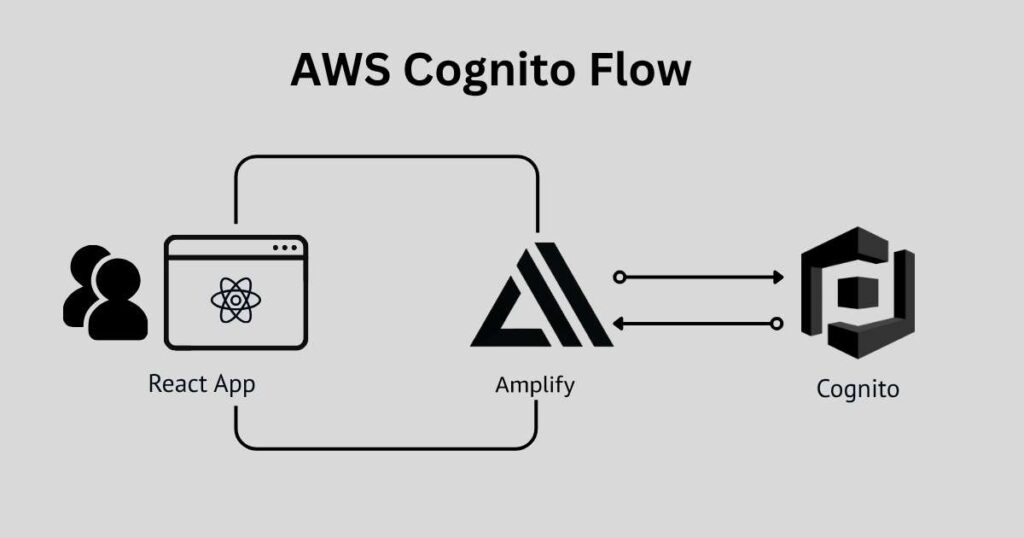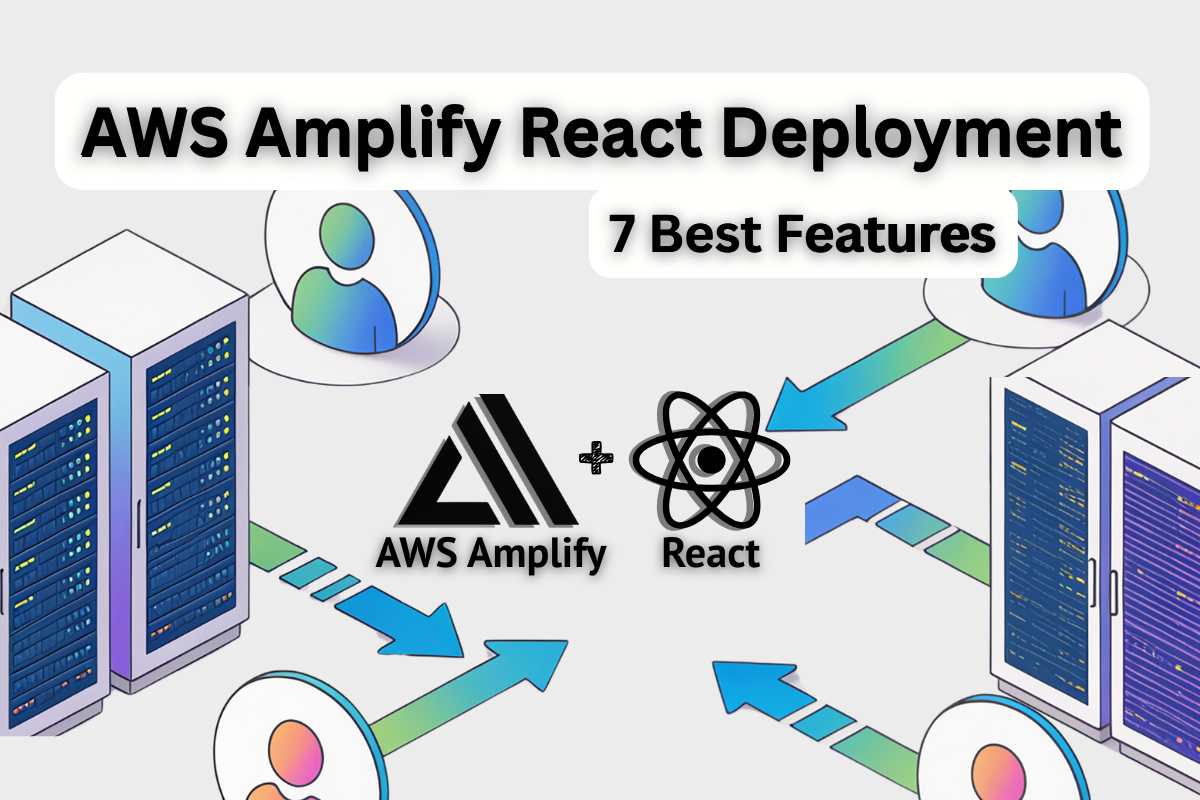AWS Amplify React deployment makes it feel simple. Instead of managing CloudFront, S3, Cognito pools, and CI/CD pipes, Amplify gives React developers a single setup to handle it all from one interface. Built fast and deployed clean!
Most React apps are not just front-end, but also need backend logic, file uploads, user management, and real-time updates. That’s why Amplify changes the game. It abstracts AWS services and provides a developer-first workflow — hosting, SSR, CDN, auth, GraphQL/REST APIs, storage, and functions — all managed through a single CLI.
In this guide, I’ll break down how AWS Amplify React deployment supercharges your project with five features: Hosting, API, Storage, Auth, and Functions.
Still learning? Check out my “What Is an API Call? Everything You Need to Know“
Why AWS Amplify Is a Killer Choice for React Apps
Deploying a React app (with real backend features) feels messy. You jump between vendors, wire up APIs, patch auth flows, and glue storage on top. Been there, felt the pain — my brain was fried, lol. That’s the problem — an AWS Amplify React deploy isn’t just pushing files to a host. It’s connecting all the moving parts — auth, APIs, storage, Lambdas — without losing sanity.
That’s why AWS Amplify feels like a cheat code. It’s not just hosting. It bundles Cognito auth, GraphQL or REST APIs, S3 storage, Lambda functions, and even a CI/CD pipeline. You get one tool, one config with minimal chaos!
If you’re building something interactive that constantly calls APIs, Amplify shines. It handles secure API calls out of the box. You don’t wrestle with tokens, headers, or random backend patchwork. Just scaffold, link your React (or Vue) app, and you’re already live.
With AWS Amplify React deployment, you have the stack running in one config file — you set it up in literally an afternoon, not a week. The speed matters when you’re hacking a prototype or shipping to enterprise production. For small teams, that saves time and money.

Here’s where Amplify wins for React AWS deploy:
- Hosting + CI/CD — deploy push-to-prod in minutes, no custom pipeline stress.
- Auth baked in — a login/signup flow with one command.
- APIs in clicks — GraphQL or REST tied directly to your React app.
- Storage made easy — file uploads, media streaming, all with access control.
- Serverless functions — quick Lambdas without drowning in AWS console settings.
So yeah — Amplify is kinda the all-in-one deployment solution for React (or Vue) apps. After shipping React projects with Amplify in production, it’s hard to go back. It’s fast, smooth, and handles multiple separate AWS services under the hood.
1. Frontend Hosting & Deployment – Ship React Fast With Branch Previews & SSR Support
AWS Amplify is a full CI/CD built directly into AWS, designed for frameworks like React or Next.js (for Server-Side Rendering). You hook up your Git repo, push a commit, and Amplify spins up the pipeline, handles the build, ships the deployment, and rolls it out on a global CDN. No extra hands, no messy scripts, no CloudFront (AWS’s CDN) configs. You even get previews for pull requests, custom domain mapping, and one-click rollbacks!
The way it works is simple. Amplify watches your repo, auto-builds, and deploys each commit. For every branch or PR, you get an isolated preview URL to test changes before merging. The infra is fully managed by AWS, scaling automatically as traffic spikes. Amplify eliminates all that manual overhead by managing S3 buckets, CloudFront, pipelines, and IAM roles, keeping the flow straightforward.
The actual process is connect → configure → deploy. You connect your Git repo, confirm the build settings with the default amplify.yml file, add env vars, and initiate the deployment. From there, you can expand into SSR (Server-Side Rendering) with Next.js or add custom settings, like headers or caching.
Rollbacks are one click, but cache invalidation, environment leaks, and untested builds are still on you. Use preview gates and be careful with changes to save time, nerves, and downtime.
2. Amplify API (GraphQL / REST) — Real-Time and Typed Data via AppSync + DynamoDB
Amplify API makes data feel fast, typed, and locked down right out of the box. AWS AppSync and DynamoDB let you choose between REST and GraphQL.
With GraphQL, you define the schema, and Amplify generates resolvers —you instantly get real-time updates. AppSync runs the engine, DynamoDB is the near-zero-latency data store, and Lambda ties it all in for custom back-end logic. REST still works fine, but you lose the type-safe queries and auto subs.
A simple flow: User enters a prompt → Amplify handles a mutation → AppSync routes it to DynamoDB or a Lambda resolver → the subscription immediately pushes back an update to React. That’s your clean cycle, real-time and type safe.
Tie Amplify API directly to your React AWS deployment setup, and the app feels fast, the data is trusted, and your workflow is smoother. It’s schema-first, subscription-ready, and built to keep UIs alive in real time.

3. AppSync — Real-Time GraphQL API for React Apps
AppSync in AWS Amplify handles how React apps get data. It’s a fully managed GraphQL service from AWS that provides real-time queries, mutations, and subscriptions. When you set up AWS Amplify React deployment and run an “amplify add api,” you can choose GraphQL. Amplify sets up an AppSync API under the hood, connecting it to DynamoDB, Lambda, or any other back-end service.
AppSync gives you one single endpoint to manage your entire app’s data flow. Queries fetch your data, mutations update or create it, and subscriptions keep it live in real time. You define your data schema once, and Amplify auto-generates the back-end logic and connections. It plugs into Cognito Auth for sign-ins, pairs with IAM for permissions, and link straight to DynamoDB or Lambda when you need some custom compute action.
Without AppSync, you’d be breaking your flow — wiring multiple REST endpoints, handling manual polling, and managing state updates. If you think about it, instead of dozens of REST routes and endpoints, everything sits behind one powerful, typed GraphQL API Gateway. Your React app sends a query, AppSync validates it, the backend fires, and the front end updates — all synced up!
Learn more about “What Is an API Gateway in Microservices“!
4. Storage & File Hosting — S3 Made Simple (Uploads, Access Rules, and UI)
When you run a React AWS deploy, file storage is a big headache — user uploads, galleries, or prompt-history files. Amplify’s Storage feature (backed by Amazon S3) makes this much smoother. You get APIs for uploads, downloads, and lists, plus React UI components from “@aws-amplify/ui-react-storage“.
But you’re NOT locked into Amplify-only buckets. You can hook into any existing S3 bucket. Access control is just as flexible — public (anyone sees it), protected (signed-in users get files), or private (locked for one user only). Storage rules run under the hood with Cognito authentication — uploads and downloads follow your access logic.
Imagine you build a prompt UI tool. A user drags a file to explain context—Amplify Storage lets you upload it instantly, save it inside the protected/ path (only for signed-in users), then pull it back later with a presigned URL. Same for showing a gallery of generated images—files get in, live in S3, then come back to React.
To set it up, first configure Storage, set access rules, and wire up React hooks (use Storage.put, Storage.get, or Storage.list). You can write a bucket policy so only Cognito-authenticated users can upload under protected/ route. Add a deny rule if encryption isn’t set—keeps data extra safe.

5. Authentication & Authorization – Cognito, Done Fast (UI Components + Hooks)
Authentication is one of the “must‑have, no excuses” features. With Amplify + Cognito, you get sign‑up, sign‑in, sign‑out, plus multi‑factor auth and password recovery.
Secure login and token implementation aren’t tasks you want to rebuild. With Amplify, you add an auth resource, configure social login (Google, Apple, etc.), use the Authenticator UI (or build custom components), and gate routes in minutes. Consistent UX —no backend thrashing.
Cognito itself powers accounts, federated identity, and MFA. You choose between pre‑built React components or going fully custom. Pre‑built is faster, styled, and easy to theme. For custom UI, hook into useAuthenticator (or use the lower‑level Auth API) and build your own forms, layouts, and flows, while Amplify still manages tokens, sessions, and refresh for you. Pre‑built = speed, custom = flexibility. Either way, tokens and session refreshes are handled under the hood.
6. Serverless / Lambda Functions & Extensibility — Custom Business Logic with Lambda
When you’re doing an AWS Amplify React deploy, sooner or later, you bump into logic that front-end alone can’t handle — prompt validation, AI calls, data tweaks. That’s where serverless functions — AWS Lambda + Amplify Functions Gen 2 — come in. They give you the backend without the running servers.
One popular use case is webhook processors. Say Stripe fires off an invoice.paid event. A Lambda grabs it, validates the request, looks up the user in DynamoDB, enriches the data, and then passes it forward into your GraphQL API. Fast, clean, and without keeping a server running for rare events.
Another setup is scheduled jobs. Through EventBridge cron rules, you trigger a Lambda nightly—maybe delete expired sessions, archive old logs, or send out daily reports. Why waste money on always-on servers when a few scheduled Lambda calls keep everything in shape?
Then there are file and image pipelines. Uploads hit S3, and Lambda responds immediately. Imagine users creating thumbnails, scanning files for viruses, or even using OCR to process uploaded PDFs. Your app stays fast while Lambda does the heavy lifting behind the scenes.
And don’t forget analytics and ML-driven workflows. A Lambda listening to event streams (Kinesis, DynamoDB streams) shapes, cleans, and enriches data before it lands in Redshift, OpenSearch, or an ML pipeline. It’s a serverless ETL stage—transforming raw logs into usable insight.
In the end, Lambda turns your AWS Amplify React deployment into something bigger. Webhooks, schedulers, file processors, API resolvers, analytics glue — it’s all there, on tap, running only when called. That’s custom backend power, minus server babysitting.
7. Integrating with Existing AWS Resources (Bring Your Own Cognito, AppSync, S3)
If you already have back-ends — like a Cognito pool, an AppSync API, or an S3 bucket — you don’t need to rebuild them. AWS Amplify React deployment can connect directly to what you have. This “bring your own” (BYO) setup keeps your setup lean, avoids duplicate resources, and saves time (and AWS bills!).
In a typical migration, the safest path is to first mirror your existing backend into a test environment. Amplify lets you reference your existing resource ARNs and endpoints directly in the client configuration. In your config aws-exports.js file, plug in those Cognito, S3, or AppSync IDs and endpoints. Once that’s stable, flip feature flags or build-time env vars to switch traffic safely. If something feels off, roll right back to your SDK setup
Supported auth types make this even smoother. You use API_KEY for public testing, AWS_IAM for secure, signed requests, AMAZON_COGNITO_USER_POOLS for user-based sessions, or OPENID_CONNECT if you use external identity providers. Most React apps stick with Cognito pools since they fit perfectly with Amplify’s built-in libraries.
Conclusion — AWS Amplify React Deployment
AWS Amplify React deployment is an all-in-one, AWS-native platform that covers hosting, APIs, auth, storage, and serverless functions. The reliability is rock-solid, and the integration with AWS services hits a whole new level. Amplify hosting feels smoother, and Amplify API hooks into Lambda and DynamoDB like magic.
If speed, simplicity, and scaling matter to you, AWS Amplify React is a great option. It’s the shortest route from an idea to a full-stack, enterprise-level app.





